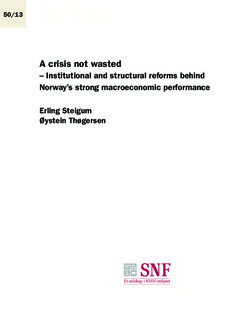A crisis not wasted : institutional and structural reforms behind Norway’s strong macroeconomic performance
Working paper

View/
Date
2013-12Metadata
Show full item recordCollections
- Working papers (SNF) [809]
Abstract
This paper draws the line between the Norwegian boom-bust cycle and crises in the late 1980s and early 1990s, the succeeding institutional and structural reforms and the strong macroeconomic performance and stability of the last two decades.
The systemic banking crisis and speculative attack on the Norwegian krone in the early 1990s were the last in a series of blows to Norway’s macroeconomic policy regime. In addition to the recession after 1988, the underlying growth potential of the Mainland economy was also weak, despite financial deregulation and the gains in competitiveness. The large oil price fall in the mid-1980s had demonstrated the risk of uncertain oil revenues as an important source of income to the government.
The political awareness of an economic crisis paved the way for a series of structural reforms and changes in the macroeconomic policy regime. Some of these reforms were implemented quickly, such as a tax reform, an energy market reform and a new incomes policy framework. In 2001 a new framework for monetary and fiscal policy was put in place, involving a flexible exchange rate and inflation targeting, as well as a new fiscal policy rule designed to facilitate consumption smoothing and a build-up of a sovereign wealth fund. We discuss possible reasons why Norway’s political system has been able to learn from previous policy failures and reach the necessary consensus, and determination, to implement institutional and structural reforms in economic policy.